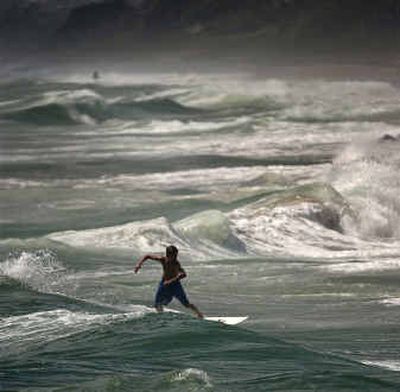Floridians flee hurricane

PORT ST. LUCIE, Fla. – Residents and tourists in cars, trucks and campers clogged highways Thursday in the biggest evacuation ever ordered in Florida, fleeing inland as mighty Hurricane Frances threatened the state with its second battering in three weeks.
About 2.5 million residents were told to clear out ahead of what could be the most powerful storm to hit Florida in a decade. Other people in the 300-mile stretch covered by the hurricane warning rushed to fortify their homes with plywood and storm shutters, and buy water, gas and canned food.
Already a Category 4 storm with 140 mph winds and the potential to push ashore waves up to 15 feet high, Frances could make itself felt in the state by midmorning. At 8 p.m. EDT, the hurricane was centered 355 miles southeast of West Palm Beach and was moving northwest at close to 10 mph. Hurricane-force winds extended up to 80 miles from its center.
This could be the first time since 1950 that two major storms have hit Florida so close together. On Aug. 13, Hurricane Charley splintered billions of dollars worth of homes, knocked out power to hundreds of thousands and killed 27 people when it tore across the state.
Charley’s example – and Frances’ tremendous size, at 1,000 miles across, or about as big as the state of Texas – prodded people like Linda Silvestri, 58, to get out of the way. Silvestri, who lives in Palm Bay on the central Florida coast, headed inland to Gainesville to be near a hospital because she just received a kidney transplant.
“I hope I have a house when I get back,” she said.
The hurricane warning covered most of the state’s eastern coast, from Florida City, near the state’s southern tip, to Flagler Beach, north of Daytona Beach. Forecasters could not say with certainty where Frances would come ashore, just that it would strike late today or early Saturday.
About 14.6 million of Florida’s 17 million people live in the areas under hurricane watches and warnings.
Gov. Jeb Bush estimated 2.5 million residents were under evacuation orders in 15 Florida counties based on the state’s projections of people living in evacuated areas. Individual counties reported at least 1.32 million residents ordered evacuated, basing their estimates on the number of people living in evacuated areas that had left their homes.
Residents and tourists streamed inland in bumper-to-bumper traffic. Traffic backed up for miles on sections of Interstate 95, the main north-south highway along the state’s east coast, and was also heavy on parts of I-4, which crosses the peninsula to connect Daytona Beach, Orlando and Tampa.
Geoff Connors of Fort Pierce sat in a line of about 50 cars slowly merging onto I-95 in Fort Pierce. He had enough cash and clothes to get through about five days, though he wasn’t sure where he would end up.
“I figured it was smarter to get out of here now. It was a snap decision,” Connors said.
The storm and the evacuations it forces are certain to spoil Labor Day outings and make a mess of holiday travel across the Southeast.